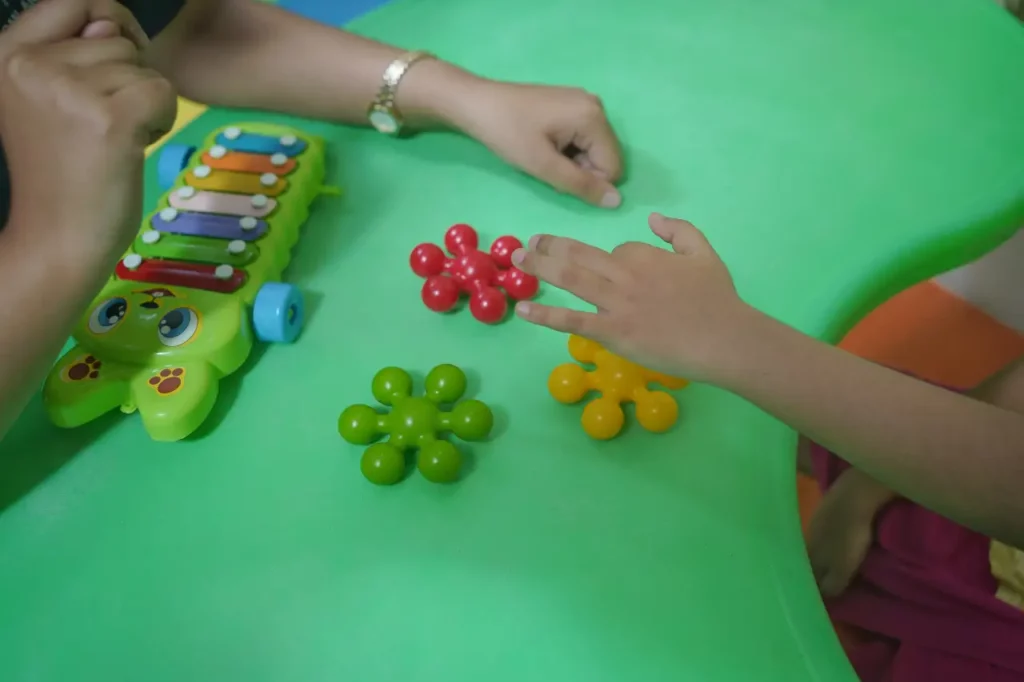
Written By
Vyshakhi vinod kumar , BASLP Speech Language Pathologist

Clinically Reviewd By
Joan Annie Jacob, BASLP, OPT(Level 2) Speech Language Pathologist
After speech therapy at the clinic, what's next? As a speech therapist, what are your suggestions for my child? How can I help my child?
As speech-language pathologists or Speech therapist, we understand that our work doesn’t end when the therapy session is over. It’s essential to be effective in our profession, which means training parents and caregivers on what to do at home is also an integral part of what we do. We always give instructions to parents on activities to do during the therapy session and at home to encourage speech and language skills of their child. It’s a collaborative effort between the clinician and the family to ensure the best possible outcomes for the child’s progress. Parent involvement and their presence during sessions are of utmost importance in implementing the techniques at home. This helps children make the maximum progress towards their speech and language goals and generalise new skills in their home and other environments. Speech therapy sessions typically last for 45-60 minutes, and it is vital that these skills are practised daily at home as a routine.
When doing activities at home, it’s really important that parents create activities which provide stimulation and ensure opportunities to foster language skills. It’s also important to start tracking your child’s progress over time, along with the clinician, to bring in modifications in the therapy activities as and when needed.
Speech therapy is an essential part of helping your child develop speech and language skills and communication as a whole. It is important to identify what they can do rather than focusing on what your child can’t do. This will help them stay motivated in life and build their confidence to communicate with others. This will be the base of our early speech and language intervention.
As each child is different, we should try different methods to understand what’s best for your child. Methods such as,
- Setting up routines and using repetitive language
- Modelling
- Setting up communicative temptations
- Giving them Choices
- Asking less, adding more
- Waiting for child’s response
- Expanding your child’s utterances or EXPANSION
- Making bedtime story a habit
- Using different modalities for child
- Giving commentary, also known as Parallel talk
- Positive reinforcement
- Starting with Simple commands
- Allowing them to give you directions
- Getting rid of the distractions
- Being silly
Suggested Reading: Benefits and Drawbacks of Speech Therapy

Set up Routines and Use Repetitive Language
Toddlers and infants with an efficient routine interact more with the people around them. When you establish a routine for your child, they feel secure and safe in their environment. Children eventually get used to the understanding of daily procedures and events. In the process, they slowly become more independent as they understand the details of each routine. Most parents admit that when routines are well predictable and flexible, it limits problems.
Repetitive language can be in any form, such as rhymes, songs, simple story books, etc.; along with it, use gestures, actions and pointing simultaneously for effective communication. Use the same words/phrases repeatedly during routine activities so that eventually, the child also uses these words and becomes part of their word repertoire.
Modelling
When you give a model and name an object, bring the object close to your mouth. Then model the word. When you put the item by your mouth before handing it to them, the child associates the meaning between the item you are holding and the word you are saying. If your child imitates after you, give it to them. If not, label it once again and give it to them.
Modelling simple language for your child helps them to imitate. It also helps them use the words/ phrases independently in meaningful contexts. Never use telegraphic speech while talking to your child. It applies to all parents irrespective of their child’s age. Parents should speak slowly to the child and give pauses in between. Do not say “poon” instead of “spoon” because that’s how a child says it or because it sounds cute.
Set up Communicative Temptations
This is an amazing way to work on language skills. Select toys or items that your child is interested in. It can be their favourite toy. The toy has to be kept out of reach of the child. When your child tries to reach out for it, hold the item next to your face and label it. Then, give your child some time to imitate it after you. If they imitate it, give the item to them. If they do not imitate, continue to label the item and give it to them.
Give them Choices
During interaction with children, give them choices. Limit asking yes/no questions like “Do you want the yellow ball?” or open-ended questions like “What do you want?” Instead, you can ask the question this way “Do you want the red or yellow ball ?” When you give your child choices, it helps them respond better, thereby reducing communicative frustration that might be caused when using open-ended questions.
Ask Less, add More
Your child may not like it when you use a lot of questions. They feel pressured and may even get frustrated. Instead, make comments on what you can hear, see, smell and touch. Make comments like “Oh, the balloon got burst ”, “The boy is crying ” instead of asking questions like “What can you see?”, “What did the boy say?”
Wait for the Child's Response
Always give your child sufficient wait time before they imitate or respond to you. Your child needs this time to process the information that they have been given. It may feel like a long time, but giving your child 10-20 seconds after you have asked them a question can be helpful.
Pause and let your child fill in the blanks. For example, “The wheels on the bus go
Round and round
All through the _______ (town)”
Expand Your Child’s Utterances or Expantion
If your child is using single words, add another word to it. For example, if your child looks at a picture of a car and says “car”, you can add another word to it, such as “red car ”, “big red car ”, etc.
Make Bedtime Story a Habit
While choosing stories, there are factors that matter – It should be age appropriate and of their receptive age. Choose stories based on your child’s interests. Use actions and modulate your voice patterns when reading to them. Point toward the words that you are reading. Use pictures to make it more attractive and interesting. This helps speech and language development. This creates a special bond between you and your child.
Use Different Modalities for the Child
Some children comprehend better when you present information visually or respond better to sounds and voice patterns and prefer some textures to play with, like clay. Use visual routines with your children so that they can remember them better and make them more attractive.
Give Commentary, also Known as Parallel Talk
Begin by using child-friendly language. Describe what your child is doing and what they are seeing, touching, hearing, eating, or smelling. For example, when they are playing with a toy, describe the toy in simple language. Say things like, “Oh! You are playing with a yellow duck. The duck says quack – quack.”
Positive Reinforcement
When your child says a new word for the first time or did a difficult task, provide them with verbal positive reinforcement. Saying, “Wow, Good job” or “Superb girl” can help build your child’s confidence and self-esteem. Even if your child pronounces a sound or word incorrectly, don’t give negative comments instead, model them.
Start with Simple commands
Giving your child simple directions (by 1 year of age) serves two goals
- Able to follow simple instructions given by caregivers and understanding that it needs to be followed.
- It improves their comprehension skills.
Ask them to do simple tasks, such as, “Go to the room, and bring the phone.” or “Bring mom some water from the kitchen”.
Allow Them to Give You Directions
Let your child tell you what he needs or what he likes to do. Let them express themselves freely. Let your child give you instructions to do what they like to do and in what manner. It is a great way to exercise your child’s analytical abilities, logical thinking and improve their expression. It doesn’t mean they should dominate parents all the time. See if your child is giving appropriate and good directions and see if it’s okay and necessary to follow them for the situation as a parent.
Get Rid of the Distractions
When it’s time to learn, switch off the TV. When it’s time to play, put your phone on silent. If you want your child to learn with you for 15 minutes, you must focus on your child and the process of learning. Be in the moment. if you are spending time with your child, don’t attend calls in between and texting others.
Spending quality time with your child is critical to their cognitive and emotional development; it creates a good bond with your child.
Be Silly
Children respond better to the actions we think will be silly, like strange sounds, silly faces, and exaggerated speech. Get down to their level, like making animal sounds or beeping like a car. Utilise the bath time with your child to make funny faces and play with them with water. Let your child be energetic and happy during play activities so that they will express themselves freely. The more fun you are, the more engaged and ready to participate they’ll be. This will be the stepping stone to help the development of speech and language in your child.
These 15 tips are suitable for all children and can be used by parents with neurodiverse kids. These tips have been in use worldwide by parents and help children develop emotional intelligence and comprehend others’ feelings. You can do these speech therapy activities at home with your child, even if they are late talkers. When in doubt, always remember to consult your Speech Language Pathologist to guide you with your home activities.

